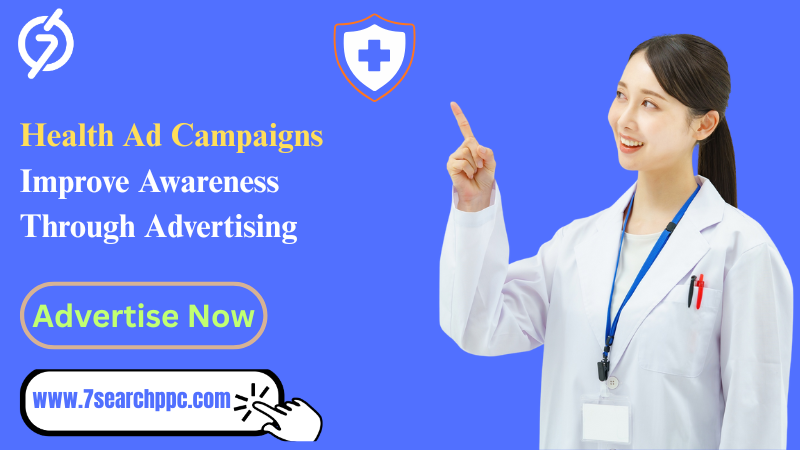How Health Ad Campaigns Improve Awareness Through Advertising

Healthcare is one of the few industries where advertising has to strike a delicate balance. It’s not just about convincing someone to buy. It’s about trust, timing, and delivering real information that can influence life choices. That’s why Health Ad Campaigns are getting so much attention.
A recent eMarketer report found that healthcare digital ad spending in the United States surpassed $12 billion in 2024. By 2028, it’s expected to nearly double. That growth doesn’t come from businesses throwing money blindly at Google and Facebook. It comes from advertisers realizing that a structured approach to healthcare promotion actually works better than general campaigns.
If you’ve ever wondered why some ads about health resonate while others feel irrelevant or even pushy, the answer lies in strategy. Structured campaigns deliver measurable impact. They’re not about chasing clicks. They’re about driving awareness where it matters most. One of the best ways to understand this shift is through the lens of Health Ad Campaigns. These campaigns show how advertisers can diagnose problems, prescribe solutions, and build credibility all at once.

The Advertiser’s Dilemma
Advertisers in this vertical face a unique set of challenges. Unlike retail or entertainment, healthcare can’t rely on flashy discounts or viral trends. You’re working with regulated messaging. You’re dealing with patients who are skeptical or overwhelmed. And you’re trying to capture attention in a space where misinformation spreads quickly.
A big challenge is relevance. Imagine you’re promoting a regional hospital’s cardiac care program. If your ads are showing up for healthy college students searching for fitness gear, you’re wasting money. Worse, it makes your brand look careless.
Another challenge is compliance. There are strict rules around what can and cannot be said. One misleading word or exaggerated promise can result in fines or reputational damage. For many advertisers, this makes the entire process feel like walking a tightrope. You want reach, but you can’t afford mistakes.
What Advertisers Overlook
What many advertisers don’t realize is that healthcare advertising is less about broadcasting and more about narrowing in. It’s about segmentation. Patients aren’t a single audience. They vary by demographics, health conditions, urgency levels, and even emotional triggers. Healthcare professionals are another distinct audience altogether.
Take Advertising to Healthcare Professionals, for example. Doctors aren’t swayed by flashy visuals or generic taglines. They want data, clinical validation, and clarity. Ads that bring them to educational webinars or case studies perform better than broad awareness campaigns.
Patients, on the other hand respond to clarity and empathy. If you’re advertising a telemedicine service, highlighting convenience and privacy resonates more than pushing technical jargon. Advertisers who miss these nuances often fail, not because the product or service is weak, but because the message wasn’t aligned with the audience.
This is where looking at Healthcare Advertising Examples becomes useful. Success stories prove that tailoring content and format to the right segment works far better than blanket strategies.
Smarter Campaigns, Stronger Results
So how do advertisers solve this without making it overly complex or expensive? The answer lies in using structured campaigns and targeted networks.
One approach is working with a dedicated health ad network. These networks are designed to place ads where they matter most. Instead of blasting a message to millions who don’t care, they position your content directly in front of patients researching conditions or professionals reviewing clinical updates.
Another tactic is Healthcare Programmatic Advertising. Programmatic tools allow you to define audiences with precision. You can segment by geography, specialty, age group, or even recent online behavior. Done well, this prevents wasted ad spend and improves conversion rates.
But technology alone isn’t enough. The best campaigns combine smart targeting with strong content. That means ads that educate, not just sell. Ads that invite the audience to take small steps, like reading a guide or signing up for a webinar, rather than pushing them straight into a purchase.
Practical Examples of What Works
Patient Awareness Campaign
A healthcare clinic launched a campaign focused on diabetes prevention during National Diabetes Month. They combined local search ads with educational video snippets on social platforms. By targeting audiences within a 25-mile radius who searched terms like “early diabetes symptoms,” they booked 30 percent more checkups that month.
Advertising to Healthcare Professionals
A pharmaceutical company introduced a new cancer drug. Instead of placing broad display ads, they invited oncologists to a CME-accredited webinar. The messaging focused on peer-reviewed trial data. Result: triple the engagement compared to their previous general awareness campaign.
Healthcare Programmatic Advertising
A medical device company used programmatic ads to separate messaging for two groups: surgeons and procurement officers. Surgeons received detailed product guides. Procurement staff saw ROI-focused ads. This double-layer targeting increased conversions by nearly 45 percent.
Why This Matters for Advertisers Today
Healthcare is crowded and competitive. Telemedicine companies, online pharmacies, and wellness apps are competing for the same attention. Traditional clinics can’t rely only on referrals anymore. They need to show up where people are searching.
That’s why Healthcare Marketing and Advertising has moved from optional to essential. Advertisers who get it right enjoy two benefits: they build trust with their audience, and they maximize their ad spend by avoiding wasted impressions.
For instance, a campaign that targets people actively searching for “skin cancer screening near me” will deliver far more ROI than a general billboard campaign that reaches everyone in a city. It’s not just about impressions anymore. It’s about meaningful outcomes like booked appointments, product trials, or professional registrations.
The ROI Perspective
- Campaigns targeting patients with preventive care messages often see 2x to 3x higher engagement rates compared to generic ads.
- Campaigns aimed at professionals with educational content drive 40 percent more participation in webinars or events.
- Programmatic campaigns reduce acquisition costs by up to 25 percent thanks to precision targeting.
When you look at numbers like these, it becomes clear that the investment isn’t justifiable. It’s essential.
CTA: Your Next Step
If you’re serious about reaching the right audiences without wasting budget, the smartest move is to create an ad campaign built for healthcare. With the right approach, you’ll not only connect with patients and professionals but also build lasting credibility in a field where trust is everything.
A Straight Talk With Advertisers
Let’s be honest. Healthcare advertising isn’t simple. You’re dealing with regulations, sensitive audiences, and a market full of competition. But it’s also one of the most rewarding areas to advertise in. Every click or registration has the potential to lead someone toward better health or even save a life.
That’s what makes mastering Health Ad Campaigns so powerful. They’re not about hype. They’re about clarity, empathy, and impact. If you can deliver those three consistently, you’ll not only run better campaigns but also contribute to something bigger than metrics.
And if you’re an advertiser who’s been on the fence, maybe it’s time to dive in. Because in this space, a smart campaign isn’t just a business win. It’s a human one.


